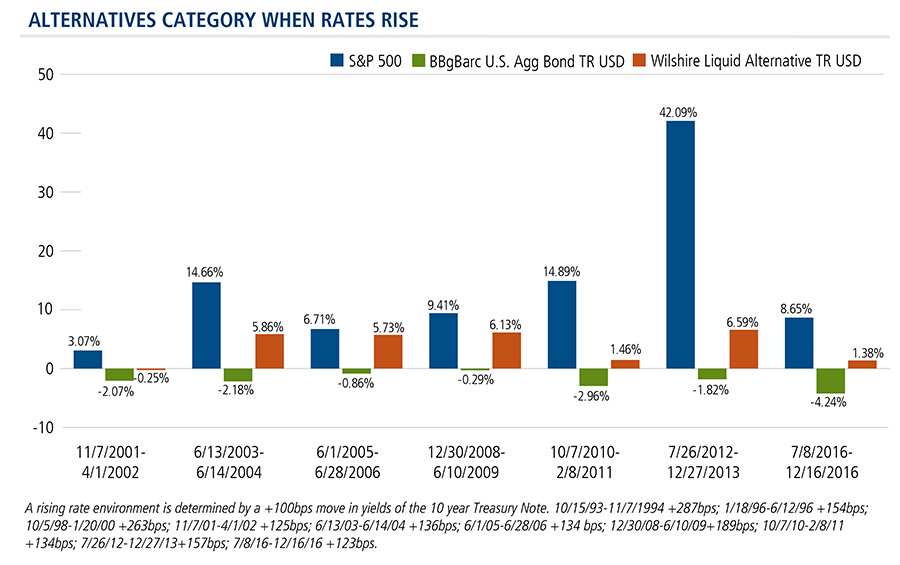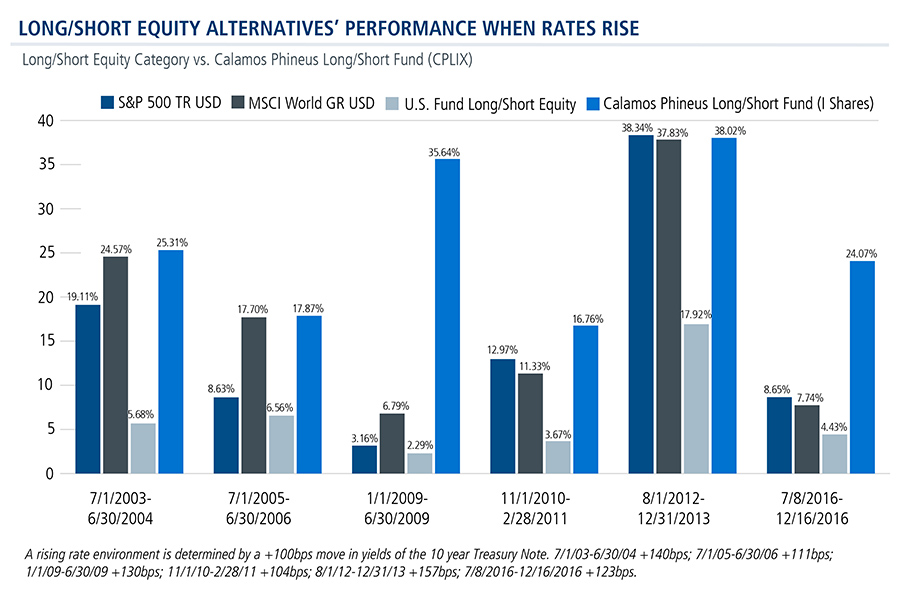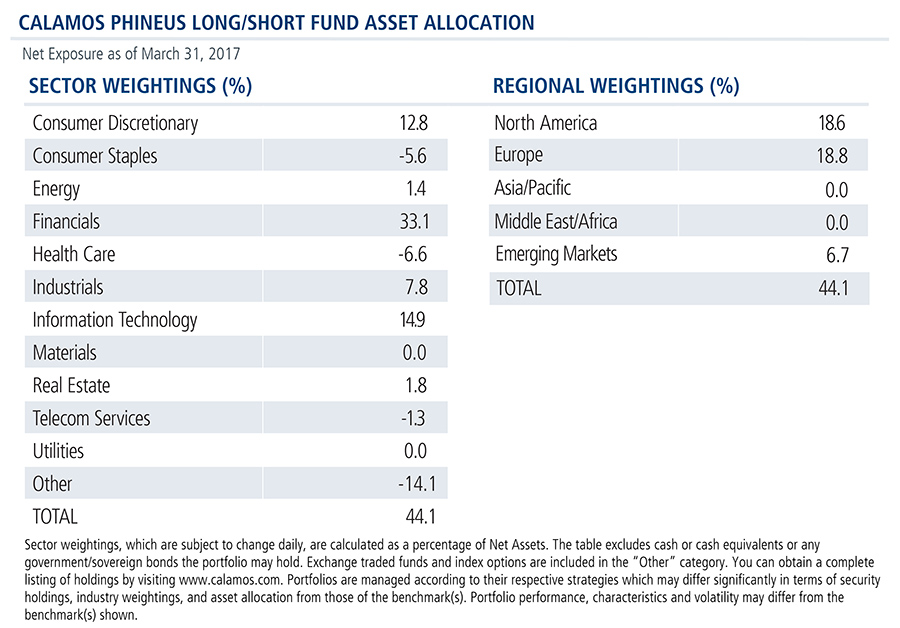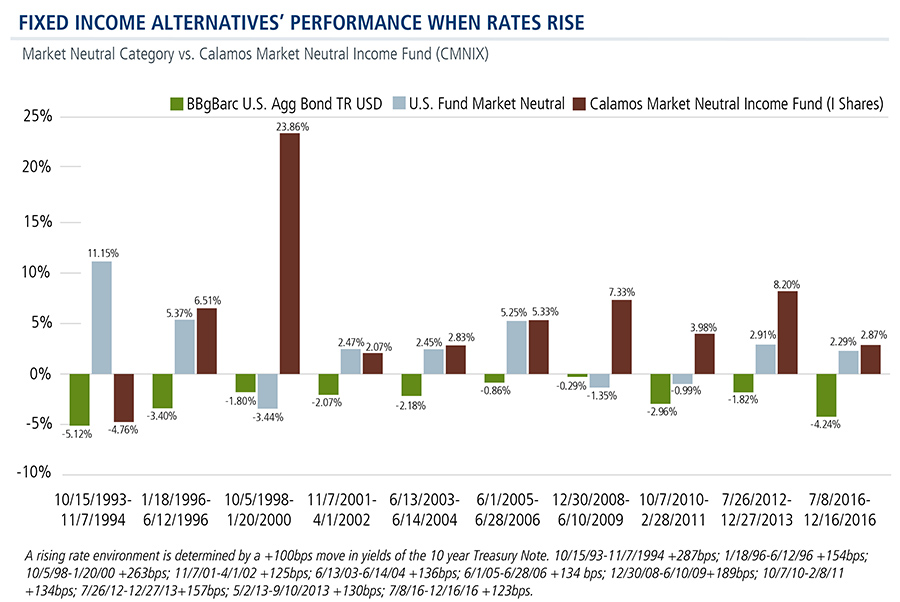First published: March 15, 2017.
The proliferation of liquid alternative mutual funds happened in response to the 2008-2009 recession, which was followed by an extended period of unusually low interest rates.
The December 2016 rate hike by the Fed was just the second in a decade. Now that the economy is believed to be in growth mode, the Fed appears to be committed to a series of rate increases including the 25-basis point hike and accompanying comments on March 15, 2017.
Equities have historically performed well when the economy is growing, justifying steadily rising rates. But what do we know about alternative funds? How do liquid alts perform when rates are rising?
The Transition to Rising Rates
Whether traditional or alternative, equity or fixed income investments are subject to the same market conditions. Below we look at market performance during eight rising rate periods over 15 years. Although each period has its own characteristics, the following typically applies to the transition to a rising rate period:
- Increased market volatility typically accompanies a regime change, as capital shifts to investments expected to benefit from a monetary tightening cycle. For example, capital moves from high-dividend paying investments (utilities, REITS, high-dividend stocks) to sectors that may benefit from economic growth and higher interest rates (technology and financials). This generally favors investors focused on equity solutions.
- Just as rate-sensitive sectors are often negatively affected, rising rates can be a challenge for fixed income investments. However, as new bonds come to the market priced at higher interest rates, yields can become more attractive to income-seekers.
- During periods of rising rates, it may be advantageous to diversify into non-U.S. markets, as valuations historically have been more attractive relative to U.S. equities.
Alternative Funds When Rates Rise
First let’s compare an alternatives category proxy (Wilshire Liquid Alternative TR USD) to a broad equity (Standard & Poor’s 500) and fixed income (Bloomberg Barclays U.S. Aggregate Bond) index.
No surprise here—growth helps drive corporate returns and generally stock prices, while rising rates can pose challenges for fixed income as a whole. Performance by alternative funds, as you can see, was middling—better than fixed income but not as strong as equities.

(click image to enlarge)
Long/Short Equity Alternative Funds When Rates Rise
Not all alternative funds are created equal. Next let’s look at equity alternatives—specifically Morningstar's Long/Short Equity category. Below we show the Morningstar category’s performance against the Calamos Phineus Long/Short Fund’s (CPLIX).

(click image to enlarge)
Since the fund’s inception in 2002, the Calamos Phineus Long/Short Fund has outperformed the Long/Short Equity category when rates have risen. And more often than not, the fund has posted notable outperformance versus the S&P 500 Index and MSCI World Index.
CPLIX’s performance reflects its ability to allocate across styles, market caps, industries and geography, avoiding the limitations of a single-style, benchmark-focused strategies that most equity products are restricted by. For example, the flexibility to short sectors that may underperform in the current economic environment (e.g., Utilities) enables the team to pursue alpha on both the long and short side. CPLIX also can invest globally.
Below is a look at the fund’s asset allocation as of March 31, 2017. The fund is positive on Financials, Information Technology, Consumer Discretionary and Industrials while underweight Consumer Staples, Telecom and Health Care. The largest region weighting of the fund (18.8%) is in Europe, immediately followed by North America.

(click image to enlarge)
Fixed Income Alternatives When Rates Rise
Now, let’s shift focus to fixed income alternatives—specifically Morningstar's Market Neutral category. Below we show the category’s performance against the Calamos Market Neutral Income Fund’s (CMNIX).

(click image to enlarge)
Since the fund's inception, the Calamos Market Neutral Income Fund has regularly outperformed the Market Neutral category and the Bloomberg Barclays U.S. Aggregate Bond Index when rates have risen.
When used within a fixed income allocation, CMNIX has historically provided bond-like returns with bond-like risk1—without having bond-like interest rate sensitivity. The Fund's lower correlation versus bonds (see below) offers a way to potentially diversify traditional fixed income while possibly minimizing the portfolio drawdowns that accompany market volatility.

(click image to enlarge)
Financial advisors, for more information about our equity and fixed income alternatives, talk to your Calamos Investment Consultant at 888-571-2567 or caminfo@calamos.com. Your consultant can also be a resource to you regarding how convertible securities perform during periods of rising rates.
Additional Ideas:
Calamos Breaks Into Top 10 of Alternative Managers
Calamos Strategies for Different Market Periods
Before investing, carefully consider the fund’s investment objectives, risks, charges and expenses. Please see the prospectus and summary prospectus containing this and other information which can be obtained by calling 1-866-363-9219. Read it carefully before investing.
Source: Morningstar and Bloomberg.
Diversification and asset allocation do not guarantee against a loss. This material is distributed for informational purposes only. The information contained herein is based on internal research derived from various sources and does not purport to be statements of all material facts relating to the information mentioned, and while not guaranteed as to the accuracy or completeness, has been obtained from sources we believe to be reliable.
Alternative investments may not be suitable for all investors. This information is provided for informational purposes only and nothing presented herein is or is intended to constitute investment advice, and no investment decision should be made based on any information provided herein.
Opinions, estimates, forecasts, and statements of financial market trends that are based on current market conditions constitute our judgment and are subject to change without notice. The views and strategies described may not be suitable for all investors. References to specific securities, asset classes and financial markets are for illustrative purposes only and are not intended to be, and should not be interpreted as, recommendations.
Class I shares are offered primarily for direct investment by investors through certain tax-exempt retirement plans (including 401(k) plans, 457 plans, employer-sponsored 403(b) plans, profit sharing and money purchase pension plans, defined benefit plans and non-qualified deferred compensation plans) and by institutional clients, provided such plans or clients have assets of at least $1 million. Class I shares may also be offered to certain other entities or programs, including, but not limited to, investment companies, under certain circumstances.
The Wilshire Liquid Alternative IndexSM measures the collective performance of the five Wilshire Liquid Alternative strategies that make up the Wilshire Liquid Alternative Universe. The Wilshire Liquid Alternative Index (WLIQA) is designed to provide a broad measure of the liquid alternative market by combining the performance of the Wilshire Liquid Alternative Equity Hedge IndexSM (WLIQAEH), Wilshire Liquid Alternative Global Macro IndexSM (WLIQAGM), Wilshire Liquid Alternative Relative Value IndexSM (WLIQARV), Wilshire Liquid Alternative Multi-Strategy IndexSM (WLIQAMS), and Wilshire Liquid Alternative Event Driven IndexSM (WLIQAED).

Performance data quoted represents past performance, which is no guarantee of future results. Current performance may be lower or higher than the performance quoted. The principal value and return of an investment will fluctuate so that your shares, when redeemed, may be worth more or less than their original cost. Performance reflected at NAV does not include the Fund’s maximum front-end sales load of 4.75%. Had it been included, the Fund’s return would have been lower. For the most recent month-end fund performance information visit www.calamos.com.
The performance shown for periods prior to 4/5/16 is the performance of a predecessor investment vehicle (the “Predecessor Fund”). The Predecessor Fund was reorganized into the Fund on 4/5/16, the date upon which the Fund commenced operations. On 10/1/15 the parent company of Calamos Advisors, purchased Phineus Partners LP, the prior investment adviser to the Predecessor Fund (“Phineus”), and Calamos Advisors served as the Predecessor Fund’s investment adviser between 10/1/15 until it was reorganized into the Fund. Phineus and Calamos Advisors managed the Predecessor Fund using investment policies, objectives, guidelines and restrictions that were in all material respects equivalent to those of the Fund. Phineus and Calamos Advisors managed the Predecessor Fund in this manner either directly or indirectly by investing all of the Predecessor Fund’s assets in a master fund structure. The Predecessor Fund performance information has been adjusted to reflect Class A and I shares expenses. However, the Predecessor Fund was not a registered mutual fund and thus was not subject to the same investment and tax restrictions as the Fund. If it had been, the Predecessor Fund’s performance may have been lower.
The MSCI World Index is a market capitalization weighted index composed of companies representative of the market structure of developed market countries in North America, Europe and Asia/Pacific region.
The S&P 500 Index is generally considered representative of the U.S. stock market.
The principal risks of investing in the Calamos Phineus Long/Short Fund include equity securities risk consisting of market prices declining in general, short sale risk consisting of potential for unlimited losses, foreign securities risk, currency risk, geographic concentration risk, other investment companies (including ETFs) risk, derivatives risk, options risk, and leverage risk.
Short Sale Risk: The Fund may incur a loss (without limit) as a result of a short sale if the market value of the borrowed security (i.e., the Fund's short position) increases between the date of the short sale and the date the Fund replaces the security. The Fund may be unable to repurchase the borrowed security at a particular time or at an acceptable price.
Leveraging Risk: Leverage is the potential for the Fund to participate in gains and losses on an amount that exceeds the Fund's investment. Leveraging risk is the risk that certain transactions of the Fund may give rise to leverage, causing the Fund to be more volatile and experience greater losses than if it had not been leveraged. The Fund's use of short sales and investments in derivatives subject the Fund to leveraging risk.
Derivatives Risk: Derivatives are instruments, such as futures, options and forward foreign currency contracts, whose value is derived from that of other assets, rates or indices. The use of derivatives for non-hedging purposes may be considered more speculative than other types of investments. Derivatives can be used for hedging (attempting to reduce risk by offsetting one investment position with another) or non-hedging purposes. Hedging with derivatives may increase expenses, and there is no guarantee that a hedging strategy will work.
Options Risk: The Fund’s ability to close out its position as a purchaser or seller of an over-the-counter or exchange-listed put or call option is dependent, in part, upon the liquidity of the option market. There are significant differences between the securities and options markets that could result in an imperfect correlation among these markets, causing a given transaction not to achieve its objectives. The Fund’s ability to utilize options successfully will depend on the ability of the Fund’s investment adviser to predict pertinent market movements, which cannot be assured.
Dispersion: describes the size of the range of values for a variable
Morningstar Long/Short Equity Category: Long-short portfolios hold sizeable stakes in both long and short positions in equities and related derivatives. Some funds that fall into this category will shift their exposure to long and short positions depending on their macro outlook or the opportunities they uncover through bottom-up research. Some funds may simply hedge long stock positions through exchange-traded funds or derivatives. At least 75% of the assets are in equity securities or derivatives.
1. The standard deviation of the Calamos Market Neutral Income Fund for 1-,3-, 5-, 10- and Since Inception is 1.29%, 3.22%, 3.38%, 3.26% and 5.49% as of 3/31/17. The standard deviation of the BBgBarc U.S. Government/Credit Index for 1-,3-, 5-, 10- and since the Calamos Market Neutral Fund Inception is 3.97%, 3.44%, 3.32%, 3.97% and 4.19% as of 3/31/17. Standard deviation represents volatility.

Performance data quoted represents past performance, which is no guarantee of future results. Current performance may be lower or higher than the performance quoted. The principal value and return of an investment will fluctuate so that your shares, when redeemed, may be worth more or less than their original cost. Performance reflected at NAV does not include the Fund’s maximum front-end sales load of 2.25%.* Had it been included, the Fund’s return would have been lower. For the most recent month-end fund performance information visit www.calamos.com. *Prior to 2/28/17, the Fund had a maximum front-end sales load of 4.75%.
The Bloomberg Barclays U.S. Aggregate Bond Index is an unmanaged index comprised of U.S. investment grade, fixed rate bond market securities, including government, government agency, corporate and mortgage-backed securities between one and ten years. Formerly known as the Lehman Brothers Aggregate Bond Index.
The Bloomberg Barclays U.S. Corporate Index consists of investment-grade corporate bonds.
The Bloomberg Barclays U.S. Government/Credit Bond Index is comprised of long-term government and investment grade corporate debt securities.
The Bloomberg Barclays U.S. MBS Index consists of securitized residential mortgages.
The Bloomberg Barclays U.S. Treasury Index includes public obligations of the U.S. Treasury.
The Citigroup 30-Day T-Bill Index is generally considered representative of the performance of short-term money market instruments.
Unmanaged index returns assume reinvestment of any and all distributions and, unlike fund returns, do not reflect fees, expenses or sales charges. Investors cannot invest directly in an index.
An investment in the Fund(s) is subject to risks, and you could lose money on your investment in the Fund(s). There can be no assurance that the Fund(s) will achieve its investment objective. Your investment in the Fund(s) is not a deposit in a bank and is not insured or guaranteed by the Federal Deposit Insurance Corporation (FDIC) or any other government agency. The risks associated with an investment in the Fund(s) can increase during times of significant market volatility. The Fund(s) also has specific principal risks, which are described below. More detailed information regarding these risks can be found in the Fund’s prospectus.
The principal risks of investing in the Market Neutral Income Fund include equity securities risk consisting of market prices declining in general, convertible securities risk consisting of the potential for a decline in value during periods of rising interest rates and the risk of the borrower to miss payments, synthetic convertible instruments risk, convertible hedging risk, covered call writing risk, options risk, short sale risk, interest rate risk, credit risk, high yield risk, liquidity risk, portfolio selection risk, and portfolio turnover risk.
Covered Call Writing: As the writer of a covered call option on a security, the fund foregoes, during the option’s life, the opportunity to profit from increases in the market value of the security, covering the call option above the sum of the premium and the exercise price of the call.
Convertible Securities Risk: The value of a convertible security is influenced by changes in interest rates, with investment value declining as interest rates increase and increasing as interest rates decline. The credit standing of the issuer and other factors also, may have an effect on the convertible security’s investment value.
Convertible Hedging Risk: If the market price of the underlying common stock increases above the conversion price on a convertible security, the price of the convertible security will increase. The fund’s increased liability on any outstanding short position would, in whole or in part, reduce this gain.
Convertible Securities Risk: The value of a convertible security is influenced by changes in interest rates, with investment value declining as interest rates increase and increasing as interest rates decline. The credit standing of the issuer and other factors also may have an effect on the convertible security’s investment value.
Morningstar Market Neutral Category: These funds attempt to reduce systematic risk created by factors such as exposures to sectors, market-cap ranges, investment styles, currencies, and/or countries. They try to achieve this by matching short positions within each area against long positions. These strategies are often managed as beta-neutral, dollar-neutral, or sector-neutral. A distinguishing feature of funds in this category is that they typically have low beta exposures (< 0.3 in absolute value) to market indexes such as MSCI World. In attempting to reduce systematic risk, these funds put the emphasis on issue selection, with profits dependent on their ability to sell short and buy long the correct securities.
There can be no assurance that the Fund will achieve its investment objective.
The opinions referenced are as of the date of publication and are subject to change due to changes in the market or economic conditions and may not necessarily come to pass. Information contained herein is for informational purposes only and should not be considered investment advice.
NOT FDIC INSURED | MAY LOSE VALUE | NO BANK GUARANTEE
800072 0317

